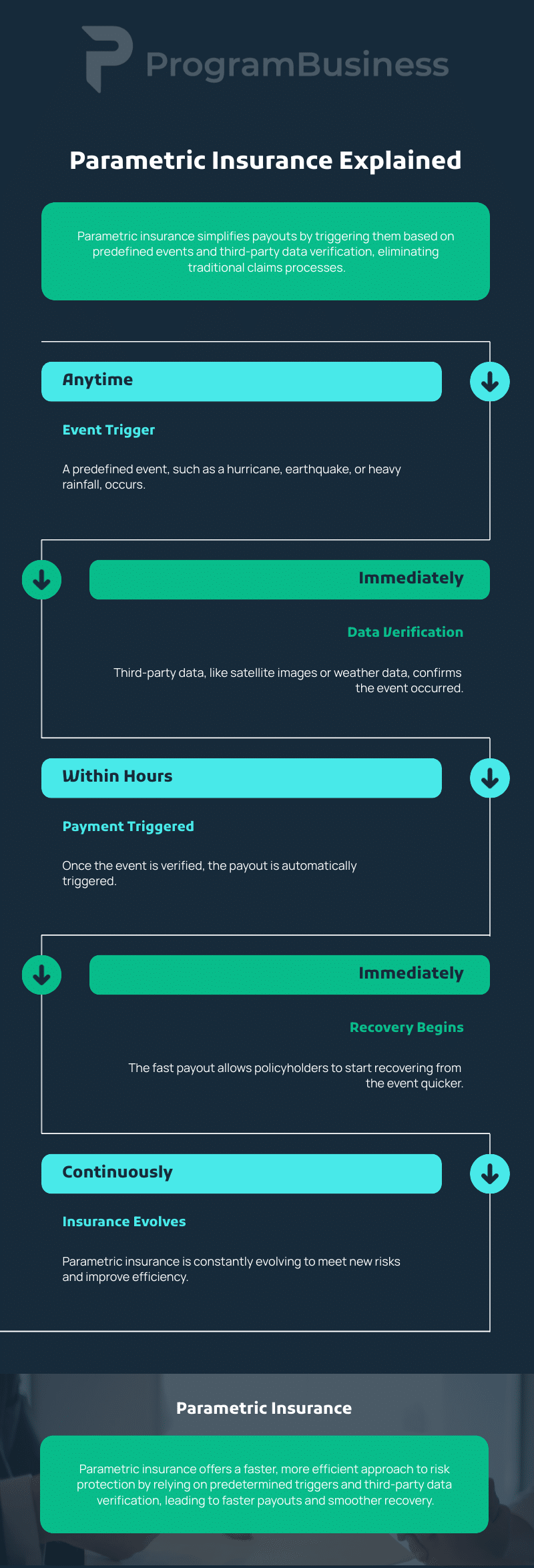As the insurance industry continues to evolve, parametric insurance has emerged as a leading alternative risk solution, favored for its ability to provide swift and reliable financial protection against emerging risks. According to a recent poll by Reinsurance News, this innovative insurance model is currently the most sought-after offering, securing 40% of the votes and surpassing structured solutions (25%), captives (21%), and complex risk offerings (14%). This trend reflects a significant shift in how businesses approach risk management in an increasingly unpredictable environment.
Key Benefits of Parametric Insurance
Parametric insurance is fundamentally different from traditional models. Instead of paying out based on the actual loss incurred, this type of insurance guarantees a payout based on predefined events. An independent third party assesses the intensity of events — such as earthquakes, hurricanes, or other natural disasters — and if the event meets the agreed parameters, the policyholder automatically receives a predetermined payout. This approach eliminates the lengthy claims process, providing businesses with quick access to capital when they need it most.
Benefit to Carriers
Parametric insurance offers numerous benefits to carriers, including improved efficiency in claims processing due to its use of predefined triggers, which reduces costs and enhances customer satisfaction. It also enriches risk management by allowing carriers to better assess and price risk, while expanding their market reach and increasing revenue by offering more accessible and cost-effective products. Additionally, parametric insurance streamlines the customer experience with easier purchasing options and drives innovation by leveraging new technologies to quickly adapt to evolving market needs. To read more on this, see Embedded Insurance and Parametric Insurance: How They’re Evolving.
Why Businesses Choose Parametric Solutions
The appeal of these insurance products lies in their simplicity, speed, and reliability. Companies impacted by natural disasters or other disruptive events benefit from prompt payouts that help maintain liquidity and ensure operational continuity. Additionally, the straightforward “if-then” model — where coverage is triggered by a specific event — makes parametric insurance an effective complement to traditional indemnity programs. This allows risk managers to better allocate capital to address the broad nature of risks posed by climate change and other unpredictable events.
Overcoming Barriers to Wider Adoption
Despite its benefits, the adoption of parametric insurance is not without challenges. A previous poll by Reinsurance News highlighted obstacles such as a lack of available data, limited models, and insufficient education about these solutions. To overcome these hurdles, the industry needs to focus on increasing awareness and understanding among businesses and risk managers.
The Role of Data in Parametric Insurance
Robust data and sophisticated modeling are crucial for ensuring the accuracy and reliability of parametric policies. In areas where reliable data on natural disasters or other risks is limited, developing effective policies becomes difficult. Investments in data collection, modeling, and educational initiatives are essential to enhance the accessibility and appeal of parametric solutions.
Comparing Parametric Models to Other Risk Solutions
The increasing demand for parametric insurance is particularly noteworthy when compared to other alternative risk solutions. For example, structured solutions are customized, non-traditional reinsurance programs designed to manage risk volatility over multiple years. While these provide benefits like tailored coverage and cost-effectiveness, they are also complex and require additional traditional insurance for full coverage.
Advantages and Disadvantages of Other Options
Captives, another popular choice, offer advantages like cost savings, tax benefits, and greater control over coverage. However, they also pose potential risks to the parent company’s capital, high startup costs, and compliance challenges. Complex risk offerings, designed for particularly intricate risks, fill gaps where traditional reinsurance falls short.
In contrast, parametric insurance stands out for its ability to deliver rapid payouts without the complexities associated with traditional claims processes. This feature is especially valuable in an era where natural catastrophes and unpredictable events are on the rise.
Climate Change and the Case for Parametric Insurance
The increasing frequency and severity of natural disasters are reshaping the risk landscape globally. Traditional property insurance, which mainly focuses on physical damage, often fails to cover broader economic exposures such as business interruption or local economic downturns. In these scenarios, parametric insurance proves invaluable.
Addressing “Grey Swan” Events
Parametric models are particularly well-suited for “grey swan” events — unpredictable but severe natural disasters like windstorms, hailstorms, and earthquakes. Integrating these solutions into a risk management portfolio can help businesses free up capital and reduce the overall cost of risk by funding a portion of the parametric policy with savings from reduced premiums.
Broadening the Scope of Coverage
Beyond natural disasters, parametric insurance can cover a range of risks, such as drops in tourism volume, pandemics, or cloud service outages. These solutions make previously uninsurable exposures insurable, providing a vital tool for unlocking contingent capital and enhancing financial resilience.
Expanding Beyond Traditional Boundaries
The flexibility of these solutions allows them to be tailored to specific business needs, making them a strategic addition to any comprehensive risk management strategy.
Looking Ahead: The Future of Parametric Insurance
As more businesses recognize the value of parametric insurance in navigating complex and uncertain risk environments, its future looks promising. However, to unlock its full potential, the industry must address challenges related to data availability, modeling, and education.
By overcoming these barriers, parametric solutions can become an even more widely adopted tool, helping businesses bridge the protection gap and build resilience against unexpected events. With the ongoing impact of climate change, the demand for innovative risk solutions like parametric insurance is set to grow, equipping companies with the financial agility needed to respond swiftly to crises and maintain operational continuity.
Additional Resources
The image below is a helpful infographic that provides a high-level overview of parametric insurance.














